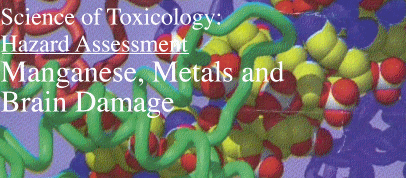 |
||||


Risk Assessment is another type of causation: predicting whether an exposure, usually in a population rather than a single individual, will increase the risk of developing some adverse health effect, without necessarily determining whether such health effect actually occurs. Risk means that all such exposed individuals are more likely to develop an adverse effect, but it does not mean that any particular individual will or even that the majority of individuals will. Smoking, for example, increases risk of lung cancer from approximately one in 100 to 1 in 10--a signficiant increase. Nevertheless, ninety percent of smokers do not develop lung cancer, even though they are all at increased risk. Risk Assessment is used by regulatory agencies, such as the EPA, to determine how much of a chemical can be released into the environment without causing an unacceptable increase in risk of an adverse effect. 'Unacceptable' is more of a policty decision than a scientific one.
Specific causation analysis can be divided into the following three components:
(1) Hazard Assessment
(2) Exposure Assessment
(3) Health Assessment
(1) Hazard Assessment: what harm can the chemical cause, based on intrinsic toxicity and circumstnaces of exposure, form of chemical (gas, liquid, solid) and susceptibility of individual.
(2) Exposure Assessment how much of the chemical is in a media (air, water, food, soil) available to be taken into the body? Is this a one-time or multiple exposure? Does it occur over a short period of time (acute) or over many months or years (chronic)? How does the length of exposure affect the toxicity of the chemical? How much of the chemical gets absorbed into the body (dose), and where in the body does it end up (distribution and target organ/tissue)?
(3) Health Assessment: what type of health effect develops (or gets exacerbated), and does this occur immediately or after a delay (lag time)? Is this a new effect in the individual or is there a history of this type of problem, made worse by the chemical exposure? Is the individual in a high risk group (in utero, infant, elderly, reduced immune function)? Are there other (alternative) known causes for this problem and were these causes present ?
Hazard Assessment
The Ohio Federal District Court’s decision to allow the jury to consider the causation linkage between manganese welding fumes and Parkinsonism was one of the few times nationwide this has been allowed. In many other cases the evidence was claimed too unclear to allow to go to a jury. In this case the jury ruled in the first phase that defendants did not fail to warn properly, so this ended the trial without consideration of the causation link. This will be for another trial and could have major repercussions since there are so many potential and actual cases nationwide, not to mention the health care and public health safety issues of this type of injury.
Manganese fumes are taken into the body through inhalation and absorbed rather easily through the lung tissue into the blood stream. Fumes are actually very small particles—particulate matter—generally one micron (millionth of an inch) or less (this compares to what EPA designates as coarse particulate matter, 10 microns or less, and fine particulate matter, 2.5 microns or less.
This heavy metal, like many heavy metals, such as lead and mercury, has a predilection for the central nervous system because of its fat solubility and the high fat content of the brain, and causes neurotoxicity as well as other possible effects. The distinction is that manganese is an essential mineral to the body, involved in many enzyme systems and as a cofactor with many other proteins. Mercury and lead are not known to have any essential biological function in the body and are considered strictly toxins.
Manganese (Mn) is actively transported into the brain, as reflected by the concentration gradient across the blood brain barrier. Although the exact mechanism of toxicity is unknown it is thought related to an accumulation in those parts of the brain in which it is otherwise normally found, particularly the palludus ….and ……. MRI’s in this region among those poisoned with manganese show biologically active effects in this part of the brain.
Manganese can cause toxicity both acutely and chronically. Most poisoning involving welding is of a chronic nature, at least six months or longer. Toxicity from manganese has been shown to cause a constellation of symptoms similar to what is seen in Parkinson’s Disease (PD) and has been referred to as manganese parkinsonism. This would be consistent with accumulation of Mn in the basal ganglia and damage to this region, as is also seen in PD.
The symptoms usually associated include tremor, rigidity, stiffness, slow movements and difficulty maintaining balance. Other findings include cognitive impairment, usually involving difficulty concentrating, which is distinct from what is seen in Alzheimer’s disease. Another characteristic seen is twitching over the entire body, and problems with hearing or dizziness. As can be seen this involves a wide range of symptoms.
A study conducted recently at Mayo clinic and reported in Neurology (Josephs et al, 2005; see also press release) claims to have ‘pinpointed for the first time’ specific set s of syndromes associated with chronic manganese exposure due to inadequate ventilation and respiratory equipment protection in welding. This finding included an area in the basal ganglia—where manganese is known to play a prominent role and to accumulate when over exposure occurs—with increased T1 signal intensity. Keith Josephs, M.D., a neurologist and one of the Mayo investigators of the study, stated that this finding was quite unusual and represented a unique marker for the sole common characteristic of the eight workers studied, manganese welding fume exposure.
Despite recognizing a number of different syndromes with different symptoms, all of the affected had similar brain involvement and T1 alterations. Dr. Josephs also pointed out that although many physicians associate manganese poisoning with the classic ‘cock walk,’ consisting of a rather dramatic and distinctive strutting and staggering gait, that in many instances of chronic poisoning, as seen in welding exposure, the symptoms are much more subtle or mild-appearing and may be misdiagnosed or missed altogether.